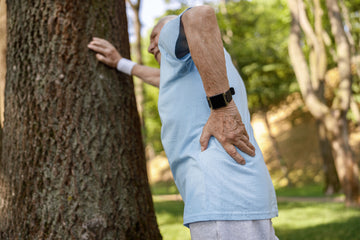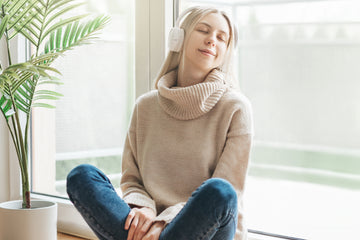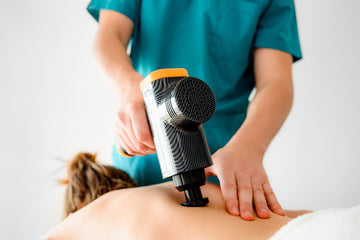You probably haven’t thought about the day when you stand up and walk, and the lower back pain shoots through you. This type of back pain can not only sneak up on you and be uncomfortable, but it can lead to other issues.
Lower back pain affects 39% of all adults in the US as of 2019 and is responsible for many people having to take a day off work to recover.. Luckily, there are ways to treat chronic lower back pain when walking so that you can still live a long and fulfilling life, not hindered by debilitating pain. In this post, we'll explore how to find relief from lower back pain, what methods you can use to address such pain at home, and the effectiveness of these methods.
What Causes Lower Back Pain When Walking?
If you have lower back pain while walking, you may not immediately know why. Back pain is a complex issue; it will take understanding your body to know exactly what's causing it and how to address it. The causes of lower back pain while walking may include:
- Poor posture: Incorrect posture can strain lower back muscles and the spine.
- Muscle imbalances: Weak or imbalanced muscle groups may contribute to pain.
- Previous injuries: Past injuries like sprains, strains, or herniated discs can resurface during walking.
Two types of lower back pain may surface: chronic and acute.
Acute pain is typically short-term and often stems from sudden injuries or overexertion during an activity like walking. It can be intense but tends to improve with rest and proper care.
Chronic lower back pain, on the other hand, persists for an extended period, usually exceeding three months. It may be linked to underlying conditions, degenerative changes, or poor biomechanics, meaning that it will require added attention to make managing it easier.
Determining the type of pain you have is crucial to finding a way to address it to avoid that pain getting worse and eventually overcoming it.
Other Considerations for Lower Back Pain When Walking
Lower back pain can come from several reasons unrelated to your flexibility and movement. Among the other things that could lead to back pain are:
- Footwear: Your shoes play a vital role in supporting your spinal column, and wearing shoes without proper cushioning can take a toll on your lower back.
- Balance: If you find yourself off-balance during your walks, it may be a sign of a deeper problem and worthy of consulting a chiropractor.
- Weight: Your skeletal structure supports your body, and the more weight it has to support, the more likely it is to lead to problems with your lower back.
- Hydration and nutrition: Being well-hydrated and adequately fed reduces the chances of lower back inflammation, which could lead to pain.
There are a number of methods to try when seeking relief, which we’ll cover below.
Exercises & Stretches To Relieve Back Pain When Walking
Stretching and exercising for lower back pain relief offers many benefits, not simply limited to giving you significant relief when a pain flare-up occurs. These exercises can help improve your posture, reduce muscle imbalances, and enhance core strength. Here's a comprehensive list of exercises and stretches you can perform from your home to help with your pain relief.
Strengthening Exercises
Strengthening exercises are fundamental to finding relief from lower back pain when walking.
These exercises help distribute the load more evenly across your lower back and reduce the strain caused by poor muscle balance. A stronger core and lower back offer better support to your spine, relieving discomfort and making it easier to maintain good posture while walking or even sitting and working from home.
- Bridges: Lie on your back, bend your knees, and lift your hips off the ground. This exercise strengthens your glutes and lower back muscles, improving stability.
- Superman: While lying on your stomach, simultaneously lift your arms and legs off the ground. This exercise engages the lower back, enhancing its strength.
- Planks: Support your body on your forearms and toes, maintaining a straight line from head to heels. Planks strengthen your core muscles, which support the lower back.
- Bird-dog: From a hands-and-knees position, extend one arm and the opposite leg, maintaining balance. This exercise enhances core stability and balance, reducing strain on the lower back.
- Cat-cow stretch: Get on your hands and knees, arching your back upward (cat) and then curving it downward (cow). This stretch helps to relieve tension in the lower back and improves flexibility.
Stretching Routines
In the battle against lower back pain, a dedicated stretching routine can significantly alleviate tension and improve flexibility in the lower back and surrounding muscles. Incorporating these stretches into your daily routine enhances the range of motion in your lower back and hips, reducing the risk of strain and discomfort during walking. Consistent stretching is crucial in helping you deal with your lower back pain, so missing a day is not ideal. Here's an example routine you can use for your stretches:
- Child's pose variation: Begin by kneeling on the floor and sitting back on your heels, then extend your arms forward. This particular stretch effectively releases tension in the lower back and spine, promoting a sense of relief.
- Seated forward bend variation: Sit with your legs fully extended and gently lean forward, reaching towards your toes. This stretch elongates the lower back and hamstrings and enhances overall flexibility.
- Lumbar rotation exercise: As you lie on your back, bend your knees and gently rotate from side to side. This movement is beneficial for alleviating stiffness in the lower back and enhancing mobility and comfort.
- Knee-to-chest technique: While lying on your back, draw your knees towards your chest and engage in a gentle rocking motion from side to side. This exercise effectively releases lower back and hip muscle tension, relieving discomfort.
- Piriformis muscle stretch: Cross one leg over the other and draw your knee towards your chest with care. This stretch specifically targets the piriformis muscle, which is known for contributing to lower back pain.
Managing Ongoing Relief for Lower Back Pain While Walking
Relief from your lower back pain when walking isn't impossible, and several useful therapies can help you address this pain over the long term. A few of these include:
- Massage chair and therapy: Massage chairs can help to alleviate pain. Regular sessions in a massage chair or professional massage therapy can help alleviate muscle tension, improve circulation, and reduce pain in the lower back, enhancing your walking comfort.
- Chiropractic care: Consistent visits to a chiropractor can address spinal misalignments and maintain proper balance in the musculoskeletal system, reducing lower back pain and improving walking posture.
- Regular exercise and stretching: Maintaining a fitness regimen that includes core-strengthening exercises, cardiovascular activities, and flexibility exercises is vital for long-term relief from lower back pain when walking.
- Ergonomic adjustments: Evaluate your workspace and daily activities for ergonomic improvements that reduce strain on your lower back during tasks like sitting, standing, or lifting.
- Meditation and stress management: Relaxation has several health benefits. Practicing mindfulness and stress reduction techniques are ways to relax that can minimize the impact of stress-related muscle tension, leading to less discomfort when walking.
Choose What Works For You
Everyone is unique in how they address their lower back pain, and choosing something you are comfortable with goes a long way toward making your life easier.
Massage chairs, for example, are excellent for their convenience and the plethora of features they offer to a person. Most modern massage chairs offer many types of massages, spanning from Thai to deep tissue. As a bonus, there's no need to call and schedule an appointment with a therapist. AI technology has made them highly efficient at remembering the massage types that appeal most to you.
While exercise and meditation also have their place, very few things can come close to the relaxation you can get from a top-tier massage chair.





